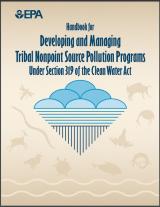Tribal Clean Water Act Programs and Grants in the Pacific Southwest
The objective of the Clean Water Act (CWA) is to restore and maintain the chemical, physical, and biological integrity of the Nation's waters. CWA programs support monitoring, assessment, protection, prevention of polluted runoff in waterways and wastewater infrastructure.
EPA's Region 9 Tribal Water Office manages all grants related to the Clean Water Act for over 100 federally recognized tribes within Region 9. The Tribal Water Office also provides programmatic and technical assistance for water quality standards and for the CWA grant programs. View CWA Project Officers.
- CWA Section §106: Water Pollution Control Grants
- CWA Section §319: Nonpoint Source Pollution Control Program Grants
- CWA Section §104(b)(3): Wetlands Program Development Grants
- CWA Tribal Set-Aside Program: Wastewater Infrastructure
- Water Quality Standards
CWA Section §106: Water Pollution Control Grants
Purpose
To assist Federally-recognized Indian Tribes develop institutional capacity to administer water quality programs and protect natural resources.
Eligible Activities (not limited to this list)
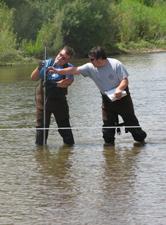 Fort McDowell Indian Tribe water quality sampling at the Verde River funded through the Clean Water Act Section 106 program.
Fort McDowell Indian Tribe water quality sampling at the Verde River funded through the Clean Water Act Section 106 program.- Performing water quality monitoring and assessments
- Carrying out activities to meet the three reporting requirements (for more information, see below)
- Develop a monitoring strategy
- Submission of data is a STORET-compatible format
- Annual Water Quality Assessment Report
- Hiring qualified staff to identify and prioritize water quality issues
- Leasing/renting office space and purchasing water quality monitoring equipment and supplies
- Developing a Nonpoint Source Assessment Report and Management Program Plan
- Conducting studies related to water pollution control
- Implementing and enforcing water pollution control measures
- Developing and implementing ground water quality monitoring programs
- Developing tribal-approved Water Quality Standards (WQS)
- Developing a 305(b) Report
- Training and travel
Funding
EPA typically awards grants between $40,000 and $200,000; first time applicants may receive grants for $40,000.
Eligibility Requirements
Contact Information
- Danielle Angeles (angeles.danielle@epa.gov)
(415) 972-3441 - Kate Pinkerton (pinkerton.kate@epa.gov)
(415) 972-3662
Guidance and Application Information
Region 9 Resources
- Region 9 Tribal Water Section Grant Fact Sheets
- Managing the Quality of Environmental Data at EPA Region 9
- FY21 Region 9 Tribal CWA 106 Funding Solicitation
(Proposed Workplans and Budgets due to Project Officers by February 1, 2021) - Region 9 Tribal CWA §106 Workplan and Budget Template(28 K, November 2020)
National Resources
- CWA Section 106 Tribal Grant Guidance
- Water Pollution Control (Section 106) Grants
- Tribal Grants under Section 106 of the Clean Water Act
Additional Resources
CWA 106 Reporting Requirements
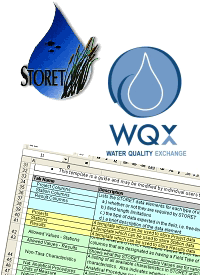 Managing and analyzing water quality data effectively is integral to the CWA Section 106 program. The program contains 3 reporting requirements that tribes must fulfill while implementing their water quality programs:
Managing and analyzing water quality data effectively is integral to the CWA Section 106 program. The program contains 3 reporting requirements that tribes must fulfill while implementing their water quality programs:
Follow these links to obtain detailed information about each reporting requirement.
Clean Water Act Section §319: Nonpoint Source Pollution Control Program Grants
Non-Point Source Grant Funding Announcement
The FY2021 Tribal Clean Water Act Section 319 Competitive Grant Request for Applications, announcement EPA-OW-OWOW-21-01, has posted to the Current Grant Information page of EPA’s Tribal NPS website. As a reminder, tribal applicants are required to submit applications to the Grants.gov Workspace, so please remind potential applicants to set up a Grants.gov account if they do not already have one. View the Grants.gov announcement page where applicants submit their competitive grant application.
Purpose
The purpose of the Nonpoint Source (NPS) Pollution Control Program is to assist tribes develop and implement polluted runoff control programs that address critical water quality concerns at a watershed level.
What is Nonpoint Source (NPS) Pollution?
NPS pollution - polluted runoff - occurs when rainfall, snow melt, or irrigation water runs over land or through the ground, picks up pollutants, and transports them into surface waters or ground water. Major nonpoint sources of pollution include agricultural practices; unrestricted livestock grazing; poor siting and design of roads, highways, and bridges; forestry; urban runoff; abandoned mines; construction sites; channelization of streams; and hydromodification, such as building and maintaining dams and levees.
Eligible Activities (not limited to this list)
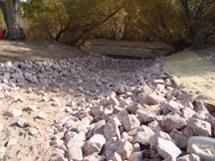 Salt River Pima Maricopa Indian Community streambank restoration and erosion control project funded through the Clean Water Act Section 319 program to reduce sedimentation by laying out rocks along the banks to hold down dirt.
Salt River Pima Maricopa Indian Community streambank restoration and erosion control project funded through the Clean Water Act Section 319 program to reduce sedimentation by laying out rocks along the banks to hold down dirt.- Road stabilization/ removal;
- Riparian planting;
- Stream channel reconstruction;
- Low impact development projects/storm water management;
- Livestock exclusion fencing;
- Springs protection;
- Septic system rehabilitation;
- NPS ordinance development;
- Project monitoring (pre-project, during project, post-project);
- Development of a watershed-based plan;
- Training which assists the applicant in development NPS implementation projects;
- Staff time and materials towards implementing projects; and
- NPS education and outreach relevant to successful implementation of NPS projects.
Funding
- Base Funding: Funds are allocated based on tribe's land area. If a tribe has 640,000 acres or less of land, the allocation is $30,000. If a tribe has more than 640,000 acres, the allocation is $50,000.
- Competitive Funding: After all base allocations are made to tribes, the remaining amount from overall national allocation is up for competition to all eligible Tribes, regardless of land size. Tribes applying for competitive funds can request up to $100,000 of federal funding.
Eligibility Requirements
Federally recognized Indian Tribes must be determined eligible to apply for CWA Section 319 funding before applying.
Contact Information
- Howard Kahan (kahan.howard@epa.gov)
(415) 972-3143
Guidance and Application Information
- FY2021 Section 319 Competitive Grant Applications due in Grants.gov January 14, 2021
- CWA 319 Tribal Base Grant Website
(FY2021 Proposed Workplans and Budgets due to Project Officers by February 26, 2021)
Resources
- Region 9 Tribal Water Section Grant Fact Sheets
- NPS Success Stories Booklet
- National NPS Program (Tribal 319 Grant Program)
CWA Section §104(b)(3): Wetlands Program Development Grants
Wetland Program
Development Grant (WPDG)
Funding Announcement
Wetland Program Development Grants (WPDGs) assist state, tribal, local government (S/T/LG) agencies and interstate/intertribal entities in developing or refining state/tribal/local programs which protect, manage, and restore wetlands. The primary focus of these grants is to develop/refine tribal wetland programs. Applications are due January 15, 2021. Awards will likely range from $25,000 to $250,000 in federal funds for a 1-4 year project period starting June 2021.
Additional Wetlands Information
The goals of EPA's wetland program include increasing the quantity and quality of wetlands in the U.S. by conserving and restoring wetland acreage and improving wetland condition. In pursuing these goals, EPA seeks to build the capacity of all levels of government to develop and refine effective, comprehensive programs for wetland protection and management.
Purpose
The wetlands program development grant (WPDG) provides states, tribes, local governments, interstate agencies, and inter-tribal consortia an opportunity to carry out projects to develop and refine comprehensive wetland programs. WPDGs provides eligible applicants an opportunity to conduct projects that promote the coordination and acceleration of research, investigations, experiments, training, demonstrations, surveys, and studies relating to the causes, effects, extent, prevention, reduction, and elimination of water pollution.
Funding
EPA typically awards between $50,000 to $350,000 per project grant. Funding is dependent upon amount requested and the overall size and need of the project.
Starting to think about developing a tribal wetlands program?
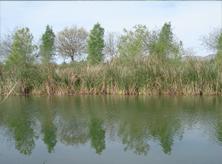 Experience with many tribes and states have distilled a set of core elements, actions, and activities that together comprise a comprehensive wetland program. EPA has summarized these common core elements, actions, and activities in the Core Elements of an Effective State and Tribal Wetlands Program Framework, also called the Core Elements Framework (CEF). The CEF describes in greater detail each of the four core elements that make up an effective state/tribal wetland program. The four core elements are:
Experience with many tribes and states have distilled a set of core elements, actions, and activities that together comprise a comprehensive wetland program. EPA has summarized these common core elements, actions, and activities in the Core Elements of an Effective State and Tribal Wetlands Program Framework, also called the Core Elements Framework (CEF). The CEF describes in greater detail each of the four core elements that make up an effective state/tribal wetland program. The four core elements are:- Monitoring and assessment
- Regulation
- Voluntary restoration and protection
- Wetland WQS
Each of these four core elements is comprised of several broad "actions" that if collectively carried out would complete that core element. In addition, each action is made up of several more specific "activities" which are the actual steps a state/tribal/local government would carry out to achieve each option. The four core elements, the set of development or refinement activities and the specific actions under the four core elements that are eligible for funding are listed at Wetland Program Development Grant.
Further Information
The full CEF can be found at Core Elements of an Effective State and Tribal Wetlands Program Framework. Some of the activities outlined in the full CEF are not eligible for the WPDG funding. The CEF provides a menu of activities for wetland program development, regardless of whether such activities are eligible for WPDG funding.
Eligibility Requirements
There are no eligibility requirements for tribes except the tribe must be federally-recognized.
Contact Information
Sarvy Mahdavi (mahdavi.sarvy@epa.gov)
(213) 244-1830
Resources
- Region 9 Tribal Water Section Grant Fact Sheets
- National Wetlands Program Development Grants Website
CWA Tribal Set-Aside Program: Wastewater Infrastructure
EPA utilizes the Indian Health Service (IHS) Sanitation Deficiency System (SDS) list to select projects that are eligible for funding. Tribes have an option of receiving a direct grant or receive an Interagency Agreement (IAG) with their corresponding IHS area office. EPA contacts the selected tribe directly and requires a written response on the selected option to receive funds.
Examples of Eligible Activities
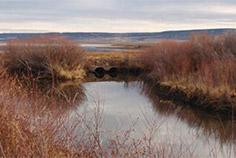 Tribal Wetlands
Tribal Wetlands- Interceptor sewers
- Wastewater Treatment Facilities (conventional or alternate)
- Infiltration/Inflow correction
- Collector sewers
- Major sewer rehabilitation
- On-site systems (e.g., septics)
Annual Funding Levels
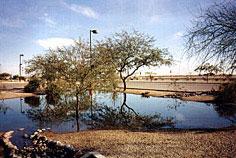 Stormwater Basin at Gila River Indian Community.
Stormwater Basin at Gila River Indian Community. - The average award amount for individual projects is $300,000. In recent years, award amounts have ranged from less than $20,000 to over $1 million. Award amounts will vary depending on the type of project.
- No matching funds are required.
Contact Information
- Loretta Vanegas (vanegas.loretta@epa.gov)
(415) 972-3433 - Nancy Sockabasin (sockabasin.nancy@epa.gov)
(415) 972-3772
Water Quality Standards
Additional WQS Information
- Region 9 Water Quality Standards
- National EPA Water Quality Standards
- Water Quality Standards Tools for Tribes
- Strategy for Reviewing Tribal Eligibility Applications
Danielle Angeles (angeles.danielle@epa.gov)
(415) 972-3441
Water Quality Standards (WQS) are the foundation of the nation's surface water quality protection program. See the National EPA Water Quality Standards web site for complete information including basic descriptions and documents for approved tribal water quality standards.
Indian Tribes can Administer the WQS Program on Tribal Land
With an approved WQS program, an Indian tribe can set the water quality goals for all surface waters (e.g., streams, rivers, lakes, and wetlands) on the reservation. The tribe will also determine whether activities which require a federal license or permit are consistent with the tribe's WQS.
How Authorization Under the Clean Water Act Benefits Indian Tribes
- Tribes establish water quality goals for reservation waters to protect water resources.
- Tribes designate uses of water bodies which may include cultural or traditional purposes
Questions About WQS Program Authorization
1. What Does a Tribe Need to Start the WQS Process for Reservation Lands?
Before a tribe may adopt standards consistent with the Clean Water Act, it must receive authorization to administer the WQS program.
2. What is Program Authorization?
- The tribe must be federally recognized
- The tribe must have a governing body that carries out substantial governmental duties and powers
- The tribe must have authority to administer the program for reservation waters
- The tribe must be capable of administering an effective WQS program
Upon receiving authorization, the tribe can submit its WQS for approval to EPA. You can submit both applications for program authorization and Tribally adopted WQS at the same time.
3. How Does a Tribe Apply for the WQS Program?
There is no standard application for program authorization. Tribes must submit documentation showing that it meets the four criteria described above. Documentation should include copies of tribal laws or regulations and other supporting information. The appropriate EPA Regional Administrator reviews the information.
Region 9 Has Approved 24 Tribal WQS Programs
A list of all tribes in the United States with TAS for Water Quality Standards can be found on EPA's National Website.

